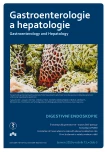Appropriate timing of bowel cleansing using low-volume preparations
Authors:
Kojecký V. 1; Matouš J. 2; Kianička B. 3; Zádorová Z. 2; Varga M. 1
Authors‘ workplace:
Interní oddělení, Krajská nemocnice T. Bati, Zlín
1; II. interní klinika FN Královské Vinohrady a III. LF UK, Praha
2; II. interní klinika FN u sv. Anny v Brně
3
Published in:
Gastroent Hepatol 2019; 73(3): 228-232
Category:
Digestive Endoscopy: Original Article
doi:
https://doi.org/10.14735/amgh2019228
Overview
Introduction: The outcome of bowel preparation depends on several factors. One such factor is proper timing, especially the duration from completion of the preparation to colonoscopy. This interval should not exceed 4 hours when using polyethylene glycol (PEG). It is unknown whether this recommendation is also valid for low-volume formulas. This study aimed to determine the appropriate timing of bowel cleansing using such formulas.
Methods: Subjects referred for a colonoscopy were prepared using PEG/ascorbic acid (MOV), picosulphate/magnesium citrate (PICO), or sulphate solution (EZI). The quality, tolerability, length of the preparation (T-pripr), and interval from completion of the preparation to colonoscopy (T-vys) were assessed.
Results: Preparation quality depended on both T-pripr and T-vys (p ≤ 0.006). The predicted T-pripr in the two best preparations was longer for PICO than for EZI and MOV (> 9.0 vs. > 7.0 and > 6.5 hours, p = 0.01). T-vys was also longest for PICO (≤ 13.0 hours, p = 0.001). There was no difference between MOV and EZI (≤ 10 and ≤ 11 hours). Time factors did not affect preparation tolerability.
Conclusion: The quality of bowel cleansing depends not only on the interval to colonoscopy but also on the length of the preparation. Optimal time points are comparable for osmotically acting low-volume laxatives, but longer for PICO. Time factors do not affect preparation tolerability.
Keywords:
colonoscopy – time factors – bowel preparation
Sources
1. Jafri SM, Monkemuller K, Lukens FJ. Endoscopy in the elderly: a review of the efficacy and safety of colonoscopy, esophagogastroduodenoscopy, and endoscopic retrograde cholangiopancreatography. J Clin Gastroenterol 2010; 44(3): 161–166. doi:10.1097/ MCG.0b013e3181c64d64.
2. Marmo R, Rotondano G, Riccio G et al. Effective bowel cleansing before colonoscopy: a randomized study of split-dosage versus non-split dosage regimens of high-volume versus low-volume polyethylene glycol solutions. Gastrointest Endosc 2010; 72(2): 313–320. doi: 10.1016/ j.gie.2010.02.048.
3. Johnson DA, Barkun AN, Cohen LB et al. Optimizing adequacy of bowel cleansing for colonoscopy: recommendations from the US multi-society task force on colorectal cancer. Gastroenterology 2014; 147(4): 903–924. doi: 10.1053/ j.gastro.2014.07.002.
4. Xie Q, Chen L, Zhao F et al. A meta-analysis of randomized controlled trials of low-volume polyethylene glycol plus ascorbic acid versus standard-volume polyethylene glycol solution as bowel preparations for colonoscopy. PLoS ONE 2014; 9(6): e99092. doi: 10.1371/ journal.pone.0099092.
5. Jin Z, Lu Y, Zhou Y et al. Systematic review and meta-analysis: sodium picosulfate/ magnesium citrate vs. polyethylene glycol for colonoscopy preparation. Eur J Clin Pharmacol 2016; 72(5): 523–532. doi: 10.1007/ s00228-016-
2013-5.
6. Siddiqui AA, Yang K, Spechler SJ et al. Duration of the interval between the completion of bowel preparation and the start of colonoscopy predicts bowel-preparation quality. Gastrointest Endosc 2009; 69(3 Pt 2): 700–706. doi: 10.1016/ j.gie.2008.09.047.
7. Hassan C, Bretthauer M, Kaminski MF et al. Bowel preparation for colonoscopy: European Society of Gastrointestinal Endoscopy (ESGE) guideline. Endoscopy 2013; 45(2): 142–150. doi:10.1055/ s-0032-1326186.
8. Falt P, Urban O, Suchánek Š et al. Czech Society of Gastroenterology guidelines for diagnostic and therapeutic colonoscopy. Gastroenter Hepatol 2016; 70(6): 523–538. doi: 10.14735/ amgh2016csgh.info19.
9. ASGE Standards of Practice Committee, Saltzman JR, Cash BD et al. Bowel preparation before colonoscopy. Gastrointest Endosc 2015; 81(4): 781–794. doi: 10.1016/ j.gie.2014.09.048.
10. Kim TK, Kim HW, Kim SJ et al. Importance of the time interval between bowel preparation and colonoscopy in determining the quality of bowel preparation for full-dose polyethylene glycol preparation. Gut Liver 2014; 8(6): 625–631. doi: 10.5009/ gnl13228.
11. Yoon JH, Park DI, Shin JE et al. Comparison of bowel preparation depending on completion time of polyethylene glycol ingestion and start time of colonoscopy. Intestinal Research 2010; 8(1): 24. doi: 10.5217/ ir.2010.8.1.24.
12. Eun CS, Han DS, Hyun YS et al. The timing of bowel preparation is more important than the timing of colonoscopy in determining the quality of bowel cleansing. Dig Dis Sci 2011; 56(2): 539–544. doi: 10.1007/ s10620-010-1457-1.
13. Seo EH, Kim TO, Park MJ et al. Optimal preparation-to-colonoscopy interval in split-dose PEG bowel preparation determines satisfactory bowel preparation quality: an observational prospective study. Gastrointest Endosc 2012; 75(3): 583–590. doi: 10.1016/ j.gie.2011.09.029.
14. Hoy SM, Scott LJ, Wagstaff AJ. Sodium picosulfate/ magnesium citrate: a review of its use as a colorectal cleanser. Drugs 2009; 69(1):
123–136. doi: 10.2165/ 00003495-200969010-
00009.
15. Kotwal VS, Attar BM, Carballo MD et al. Morning-only polyethylene glycol is noninferior but less preferred by hospitalized patients as compared with split-dose bowel preparation. J Clin Gastroenterol 2014; 48(5): 414–418. doi: 10.1097/ MCG.0b013e31829f30e9.
16. Choi HS, Shim CS, Kim GW el al. Orange juice intake reduces patient discomfort and is effective for bowel cleansing with polyethylene glycol during bowel preparation. Dis Colon Rectum 2014; 57(10): 1220–1227. doi: 10.1097/ DCR.0000000000000195.
Labels
Paediatric gastroenterology Gastroenterology and hepatology SurgeryArticle was published in
Gastroenterology and Hepatology

2019 Issue 3
- Metamizole vs. Tramadol in Postoperative Analgesia
- Metamizole at a Glance and in Practice – Effective Non-Opioid Analgesic for All Ages
- Possibilities of Using Metamizole in the Treatment of Acute Primary Headaches
- Current Insights into the Antispasmodic and Analgesic Effects of Metamizole on the Gastrointestinal Tract
- Spasmolytic Effect of Metamizole
Most read in this issue
- Acute complications of hiatal hernias
- Interesting endoscopic image of MALT lymphoma of the stomach
- Heme iron in substitution of sideropenia and sideropenic anemia
- Renal complications of acute and chronic liver disease
